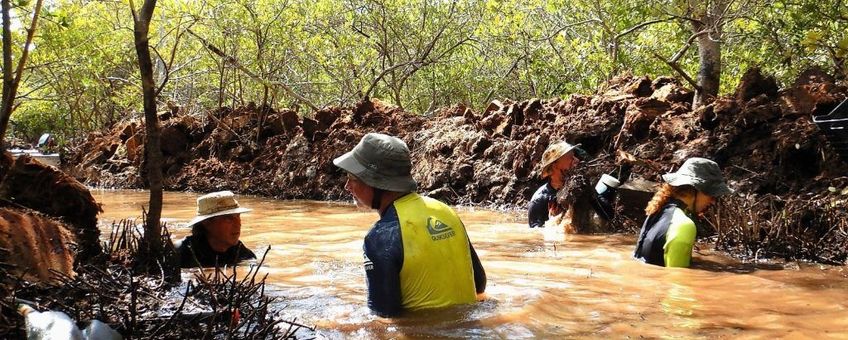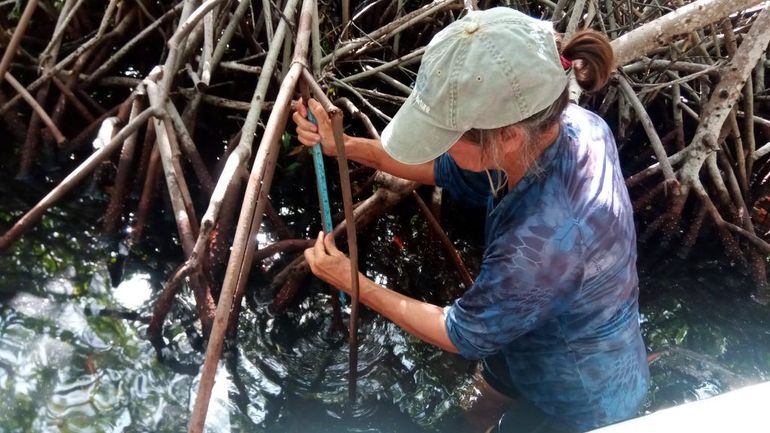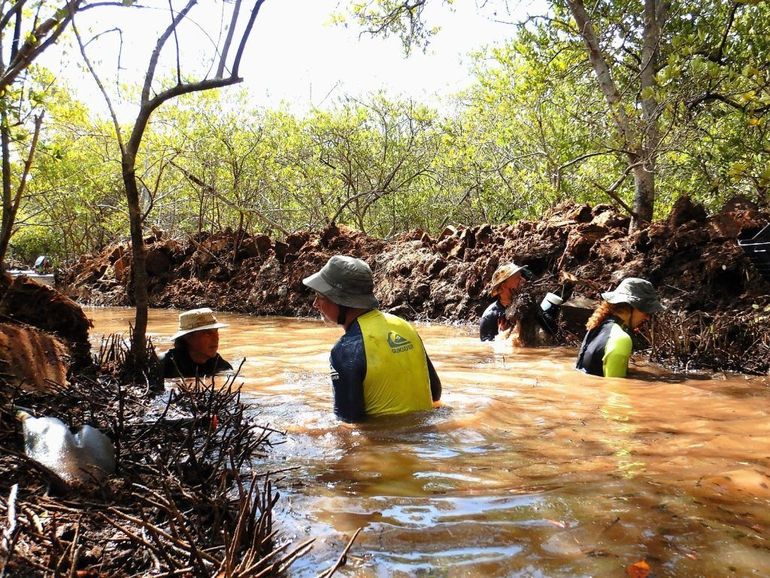
Key insights for mangrove restoration on Bonaire
Dutch Caribbean Nature Alliance (DCNA), Mangrove ManiacsLac Bay and its mangroves

When a mangrove forest experiences die-off, the important services it provides are lost: coastal protection, habitat for marine species, and carbon storage. This is currently the case with the northern part – also called Awa di Lodo – of the mangrove forest in Lac Bay. Unsustainable overgrazing by livestock has resulted in a depletion of ground cover vegetation. Wind, vehicle traffic and rainwater run-off therefore cause a high influx of sediment into Awa di Lodo. The sediment build-up clogs lagoons and creeks, reducing the hydrological connectivity between the front and back of the forest. This results in hypersaline conditions which cause the trees to die.
To fight this die-off, the Mangrove Maniacs dig channels to increase the tidal exchange and thereby improve the water quality conditions. They also plant mangrove propagules of two different species: red mangroves (Rhizophora mangle) and black mangroves (Avicennia germinans). These propagules are similar to a seed. They are grown in special ‘nurseries’ and are then planted in degraded areas or along the southwest coast to promote coastal protection. By monitoring propagule growth and survival as well as water quality parameters, we can increase our knowledge on the relationship between these factors and improve management plans for mangrove restoration and reforestation.
Tale of two studies: mangrove growth and survival
A long-term monitoring study between 2016 and 2020 investigated red mangrove growth by comparing a healthy and a degrading area. The diameter at breast height (DBH; about 1.3 m above ground surface) and the growth of aerial roots was measured monthly. The results showed a clear difference in mean aerial root growth between the healthy and degraded locations. In general, it was seen that healthier sites had higher aerial root growth whereas the degrading areas had more DBH growth. Since the degrading area experiences a higher sun exposure due to a less dense canopy, these results would imply that shade promotes aerial root growth, while tree DBH keeps increasing in more sunny areas. In healthier areas, more energy is dedicated towards growing aerial roots, which could be the reason for the slower DBH growth.

Another experiment with black and red mangrove propagules was carried out between 2020 and 2022. Here, the growth and survival of propagules in five different locations in Lac Bay was monitored: Pedro, Kaminda Sorobon, Isla Yuwana, Rand and Taco (see map) The salinity levels were also measured at these places. The monitoring took place along the regular hydrological restoration in the area, aiming at a better refreshment of water and improving conditions. During the propagule experiment the salinity levels have decreased over time at all locations, which is an expected result of the hydrological restoration efforts. Survivability rates of red mangrove propagules was found to be higher than that of black mangrove propagules due to inundation times. Further experiments where inundation changes are excluded are needed to assess the effects of salinity.

Future implications
The two studies clearly showed that salinity levels have decreased over the last years due to Mangrove Maniacs’ restoration efforts, although the levels are still high. In general, more degraded areas had a higher salinity and also lower growth rates. Red mangrove propagules seem to have a higher resilience for changes in water level and salinity than black mangrove propagules. Their strategy of fast growth under a wide range of environmental conditions would be a reason to prefer red mangroves over other species for outplants in locations more susceptible to environmental change, like the southwest coast with sea level rise. The decrease in salinity over time shows the importance of channel maintenance in the mangrove forest of Lac Bay. To further improve water circulation and thus the health of the forest, new channels would be needed. This is already in the planning of the Mangrove Maniacs.
More information
- If you want to learn more, follow the Mangrove Maniacs on social media or come out to volunteer with them on Tuesday mornings at 8am in Lac Cai, boat space is limited so please sign up via Facebook.

Text: Josien Hendricksen
Photo's: Monique Grol; Josien Hendricksen; Arno Verhoeven
